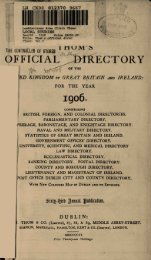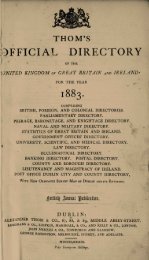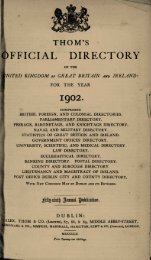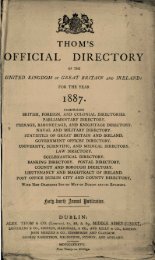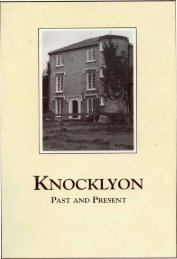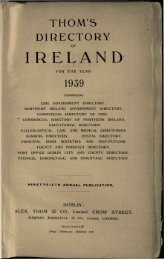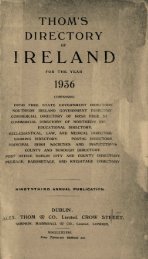behind scenes - Source
behind scenes - Source
behind scenes - Source
You also want an ePaper? Increase the reach of your titles
YUMPU automatically turns print PDFs into web optimized ePapers that Google loves.
Dublin's Mansion House, designed for<br />
King George IV's visit in 1821.<br />
The church is built entirely of local<br />
granite with a slated roof. The north<br />
and south walls have tall lancet windows,<br />
all originally with small leaded<br />
panes, the walls being divided into sections<br />
by six buttresses on each side corresponding<br />
with the interior transverse<br />
arches. These arches perhaps surprisingly<br />
are of timber plastered over to look<br />
like stone and serve no useful purpose<br />
as they would be quite incapable of<br />
load bearing. The west end with its high<br />
arched entrance door is surmounted by<br />
the bell tower and tall spire. One of the<br />
original windows, somewhat shortened,<br />
can still be seen on the south wall<br />
<strong>behind</strong> the reading desk from the time<br />
when the present vestry room was<br />
added in 18 7 6. The erection of this useful<br />
addition to the building was the result<br />
of the generous gift from the family<br />
of the late Courtney Kenny Clarke of<br />
Larch Hill, a brass plaque over the door<br />
leading into the vestry room commemorating<br />
this fact. The unstained east<br />
window also consists of small leaded<br />
panes, although again this is not the original<br />
for the church as built did not<br />
have the present chancel. What is now<br />
the chancel arch was part of the original<br />
end wall which contained a fine Gothic<br />
style window with an oak sill.<br />
Some of the items in the original estimate<br />
and specification make interesting<br />
reading; for example fourteen and a<br />
half perches of mason work was to go<br />
into the foundation of the tower, large<br />
blocks not less than three hundredweights<br />
in weight to be bedded in mortar.<br />
One marvels at the enormous task<br />
of transporting and putting into position<br />
granite blocks of this size before<br />
the advent of motor vehicles and<br />
cranes—the workmen of that time<br />
were made of sterner stuff! The cost of<br />
the fourteen and a half perches of<br />
masonry was to be the sum of £6.10.6.<br />
The two doors cost £2.0.0 each, complete<br />
with iron rimmed locks, whilst<br />
the magnificent Gothic window came<br />
out at £50-0-0 complete.<br />
There are two stained glass windows,<br />
that on the south side having been<br />
erected to the memory of the late<br />
Colonel Hercules Rowley, for many<br />
years a valued member of the Select<br />
Vestry. This magnificent window incorporates<br />
a scene from The Book of<br />
Revelation, Chapter 14 and Verse 13<br />
with the words T heard a Voice from<br />
Heaven saying unto me "Write from<br />
henceforth, Blessed are the Dead which<br />
die in the Lord". Even so saith the Spirit<br />
for they rest from their labour.'The<br />
erection of a memorial window to commemorate<br />
the members of the parish<br />
who gave their lives in the 1914—1918<br />
War was considered in January 1920<br />
and a suitable design was approved,<br />
Messrs. J. Clarke & Son being commissioned<br />
to provide a window at a cost<br />
not exceeding £100, to be erected on<br />
the north side of the church, opposite<br />
the Rowley window. Apparently the<br />
window as fitted did not comply with<br />
the design approved as in November<br />
1921 the contractor was instructed to<br />
remove the figures included in the design<br />
which departed from that intended.<br />
Presumably this was done to the<br />
satisfaction of all concerned as there is<br />
no further reference in the minutes.<br />
The window is dedicated to the memory<br />
of the following who made the supreme<br />
sacrifice:<br />
Captain W.J. Davis-60th Rifles 1915<br />
2nd Lieutenant E. Farren—Black<br />
Watch 1915<br />
Pte. Robt. McFadzean—Cameron Highlanders<br />
1915<br />
Lieutenant H. G. Killingley—Royal<br />
Dublin Fusiliers 1916<br />
Pte. G. Baldwin-Tank Corps 1917<br />
2nd Lieutenant W. C. Tosdevon—<br />
14



